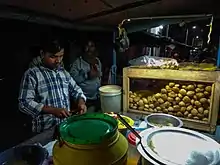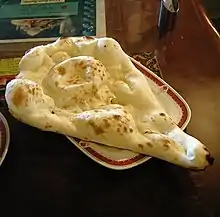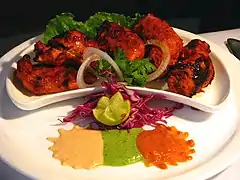 Panipuri | |
| Alternative names | Sanskrit name - Jalapatra Paani patashi/Pani puri (Maharashtra , Gujarat, Sindh, Madhya Pradesh, Uttar Pradesh) Golgappa, gol gappay or gol gappa (Haryana, Delhi, Punjab, Karachi or other Urdu-speaking regions of Pakistan) Fuchka/Phuchka/Phuska/Puska/Fuska (Bengal, [Bangladesh and West Bengal] Bihar, Nepal, North Odisha and Assam) Gupchup (Odisha, Southern Jharkhand and Chhattisgarh) |
|---|---|
| Type | Snack |
| Place of origin | Indian subcontinent [1] |
| Region or state | Indian subcontinent |
| Main ingredients | Flour, spiced seawater, onions, potatoes, chickpeas, tamarind |
| Variations | Sev puri, Puri |
Panipuri (ⓘ)[lower-alpha 1] is a deep-fried breaded sphere filled with potato, onion, or chickpea. It is a common street food in the Indian subcontinent. It is often spiced with tamarind chutney, chili powder, or chaat masala.[2][3][4] A Bengali variant, fuchka,[lower-alpha 2] uses spiced mashed potatoes as the filling.[5]
Names

Panipuri has many regional names in the Indian subcontinent:[6][7] Maharashtra: Pani Puri; Haryana: paani patashi; Madhya Pradesh: fulki; Uttar Pradesh: pani ke batashe/padake; Assam: phuska/puska; Gujarat: Pakodi; Odisha: Gup-chup; Pakistan, Delhi, and Northern India: Gol Gappa; Bengal, Bihar, and Nepal: Phuchka.
History
According to culinary anthropologist Kurush Dalal, chaat originated in the North Indian region of what is now Uttar Pradesh. Gol Gappa originated In India. He also noted that it possibly originated from Raj-Kachori: an accidentally-made smaller puri giving birth to panipuri.[8] Panipuri spread to the rest of India mainly due to the migration of people from one part of the country to another in the 20th century.[3]
On 10 March 2005, the word "panipuri" was added to the Oxford English Dictionary.[9]
Evolution over time
.jpg.webp)
Panipuri has evolved significantly over time. Originally known as "gol gappa," the dish consisted of a small, hollow, fried wheat shell filled with spiced mashed potatoes and served with a tamarind or mint-flavoured water. Over time, variations of the filling and the flavoured water emerged, reflecting the regional preferences and availability of ingredients. The flavoured water, also known as the "pani," is an essential component of the dish and is often the main source of flavour. Some of the most popular flavours of panipuri include the traditional tamarind and mint water, as well as spicy variations like jalapeño or green chili water, and tangy flavours like lemon or tomato water.[10] Some regional variations also use sweet flavours like fruit juices or dates.[10]
Gallery





 Sooji Puri used in panipuri
Sooji Puri used in panipuri Homemade panipuri
Homemade panipuri
See also
References
- ↑ "Why Bangladeshi fuchka is among Asia's top street foods". The Times of India. 4 September 2022. ISSN 0971-8257. Retrieved 1 October 2023.
- ↑ Tarla Dalal, Chaat Cookbook., Gardners Books, 2000, 116 p. ISBN 978-81-86469-62-0
- 1 2 Ramadurai, Charukesi (3 June 2020). "Pani Puri: India's favourite street food... at home?". BBC Travel. Archived from the original on 7 September 2020. Retrieved 25 August 2020.
- ↑ "MANGEZ AU NÉPAL I; L'ALIMENTATION DE RUE". JAPANFM (in French). 19 December 2020. Archived from the original on 11 November 2021. Retrieved 26 December 2020.
- ↑ Desk, L. S. (30 August 2022). "Is the fuchka overrated?". The Daily Star. Retrieved 1 October 2023.
- ↑ "There are 10 different names for pani puri. How many do you know?". 6 March 2018. Archived from the original on 9 November 2020. Retrieved 15 January 2021.
- ↑ Ladage, Rutu (9 May 2017). "11 Different Names For Your Favourite Pani Puri". The Times of India. Archived from the original on 10 March 2021. Retrieved 12 June 2017.
- ↑ "How Golgappa Originated | The tangy story of Golgappa-India's favorite street food!". The Times of India. 19 May 2020. Archived from the original on 14 June 2020. Retrieved 30 September 2020.
- ↑ "March 2005 Update". Oxford English Dictionary. Archived from the original on 24 July 2020. Retrieved 24 July 2020.
- 1 2 Dalal, Tarla (2013). Mumbai Roadside Snacks. India: Sanjay & Co. ISBN 9788189491666.




